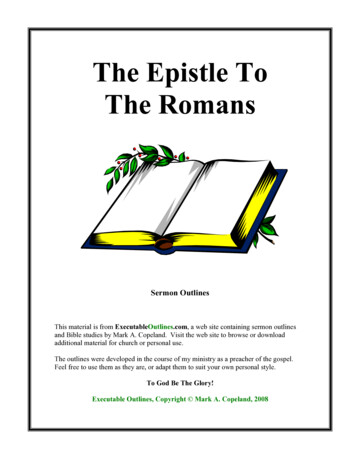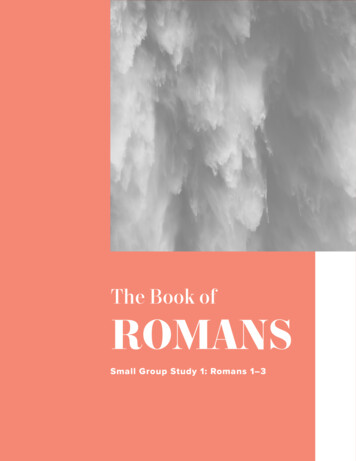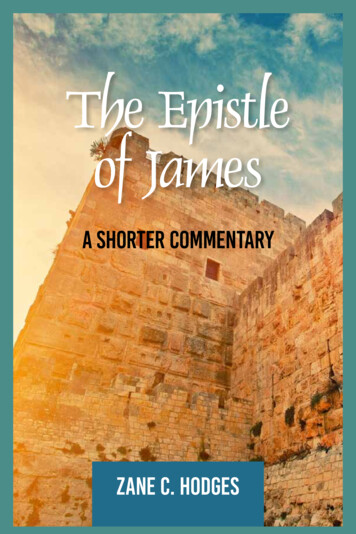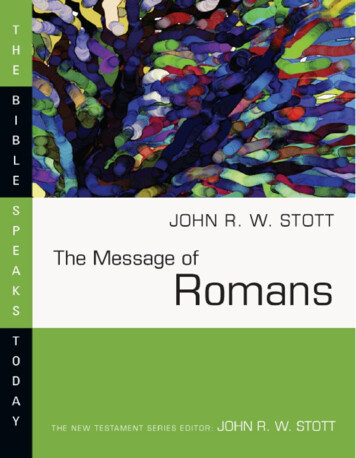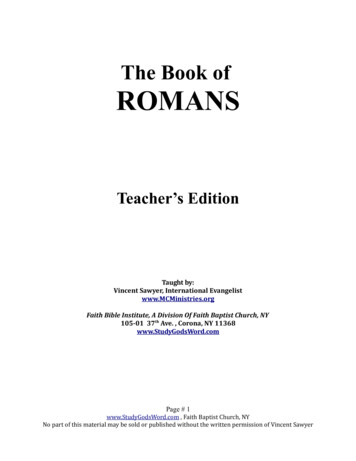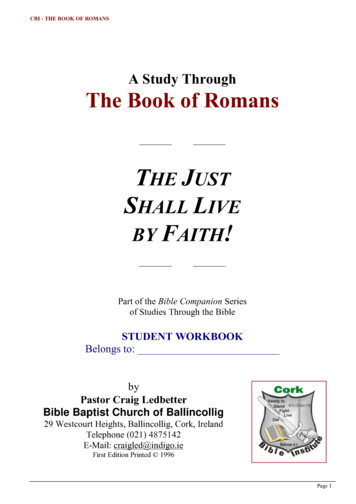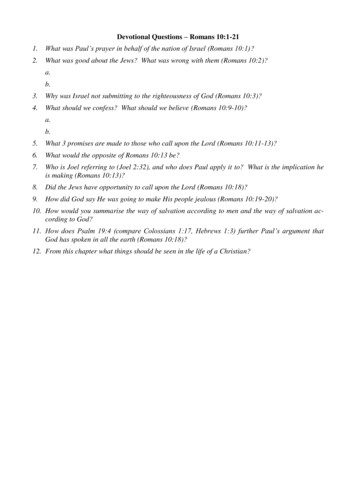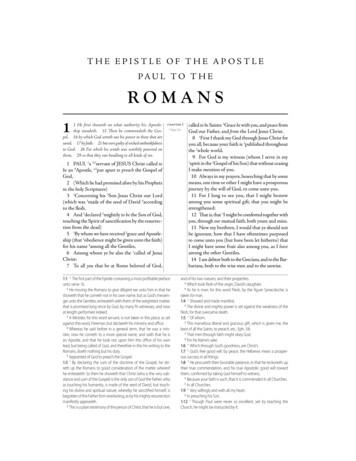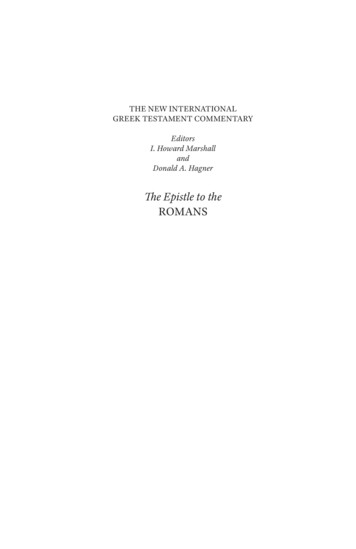
Transcription
THE NEW INTERNATIONALGREEK TESTAMENT COMMENTARYEditorsI. Howard MarshallandDonald A. HagnerThe Epistle to theROMANS
The Epistle to theROMANSA Commentary on theGreek TextRichard N. LongeneckerWilliam B. Eerdmans Publishing CompanyGrand Rapids, Michigan
2016 Richard N. LongeneckerAll rights reservedPublished 2016 byWm. B. Eerdmans Publishing Co.2140 Oak Industrial Drive N.E., Grand Rapids, Michigan 49505Printed in the United States of America22 21 20 19 18 17 16 7 6 5 4 3 2 1Library of Congress Cataloging-in-Publication DataLongenecker, Richard N.The Epistle to the Romans: a commentary on the Greek text / Richard N. Longenecker.pages cm. — (The New International Greek Testament commentary)Includes bibliographical references.ISBN 978-0-8028-2448-6 (cloth: alk. paper)1. Bible. Romans — Commentaries. I. Title.BS2665.53.L66 2015227′.107 — dc232015030832www.eerdmans.com
ContentsForeword Preface Abbreviations Bibliography of Selected Commentaries and CommentaryMaterials Bibliography of Supplemental Monographs, Articles, and OtherMaterials INTRODUCTION TO THE COMMENTARY 1.2.3.4.5.Romans vis-à-vis Paul’s Other Letters Major Critical Issues in the Study of Romans Distinctive Exegetical Treatments of the Present Commentary Prominent Thematic Features of the Present Commentary The Greek Textual Tradition of Romans ixxixvixxviiixxxv114182027COMMENTARY PROPER 41The Opening Sections of the Letter 43I. Salutation (1:1-7) II. Thanksgiving (1:8-12) 4599v
ContentsThe Body Sections of the Letter 125A. Body Opening 127III. A Brief Introduction to Paul’s Protreptic Message (1:13-15) B. Body Middle 131145IV. Section I: Righteousness, Faithfulness, and Faith (1:16–4:25) 146Part One of Section I (1:16–3:20) 1511. Thesis Statement on Righteousness, Faithfulness, and Faith(1:16-17) 1542. God’s Wrath against Human Rebellion, Idolatry, andDebauchery (1:18-32) 1893. God’s Condemnation of All Who Sin Is Just and Impartial(2:1-16) 2324. Denunciations of Jews and Jewish Failures (2:17-29) 2905. The Situation of the Jews before God (3:1-20) 325Part Two of Section I (3:21–4:25) 3786. The Thesis Statement Developed, Supported, andElucidated (3:21-31) 3887. The Example of Abraham with Respect to Righteousnessand Faith (4:1-24) 4708. Concluding Early Christian Confessional Statement (4:25) 535V. Section II: Peace, Reconciliation, and Life “in Christ” (5:1–8:39) 5381. Transitional and Thesis Passage on “Peace” and“Reconciliation” (5:1-11) 5482. The Universal and Foundational Redemptive Story: WhatJesus Christ Effected vis-à-vis What Adam Brought About(5:12-21) 5753. Three Important Questions, with an Interjected Illustrationand Statement (6:1–7:13) 604Question One: “Should We Continue in Sin So That GraceMay Increase?” (6:1-14) 606Question Two: “Should We Sin Because We Are Not underthe Law but under Grace?” (6:15-23) 617Interjected Illustration on the Extent of the Authority of theMosaic Law and Statement regarding a Christian’s Freedomfrom the Law (7:1-6) 627Question Three: “Is the Law Sin?” (7:7-13) 638vi
Contents4. Soliloquy on the Tragic Plight of Those Who Attempt toLive Their Lives Apart from God, “under Their Own Steam”(7:14-25) 6475. No Condemnation and New Life for People “in ChristJesus” and Therefore “in the Spirit” (8:1-17) 6756. Life in the Spirit, Both Personal and Universal and BothPresent and Future: A Life of Suffering and Glory (8:18-30) 7117. A Triumphal Affirmation of God’s Vindication, Care,and Eternal Love for People “in Christ Jesus,” with EarlyChristian Confessional Materials Incorporated (8:31-39) 743VI. Section III: The Christian Gospel vis-à-vis God’s Promises toIsrael (9:1–11:36) 7651. Introduction: Paul’s Great Desire for his People, Israel’sHeritage, and Israel’s Messiah, with a Closing “Amen” (9:1-5) 7792. Part I of Paul’s Exposition: God’s Promises Given to “theRemnant” of Israel, with OT Passages Cited in Support(9:6-29) 7963. Part II of Paul’s Exposition: Israel’s Present Failure andthe Gentiles Blessed, with OT Passages Cited in Support(9:30–10:21) 8274. Part III of Paul’s Exposition: The Course of God’s SalvationHistory: A Remnant within Israel, a Remnant among theGentiles, the Salvation of “All Israel,” and God’s Mercy onAll People (11:1-32) 8665. Doxology: A Hymn of Praise to God for His Wisdom andKnowledge, Incorporating Early Christian ConfessionalMaterials (11:33-36) 906VII. Section IV: Exhortations, Both General and Specific (12:1–15:13) 9111. Opening Appeals and a Statement regarding Dedication,Commitment, and Discernment (12:1-2) 9172. Appeal for Humility and Mutual Service among Believers inJesus (12:3-8) 9263. The Christian Love Ethic, Part I (12:9-21) 9324. Exhortations regarding Christians and the State (13:1-7) 9455. The Christian Love Ethic, Part II (13:8-14) 9736. On Relations among the Christians at Rome (14:1–15:13) 986C. Body Closing VIII. “Apostolic Parousia” (15:14-32) 10211023vii
ContentsThe Concluding Sections of the Letter IX. Peace Blessing, Commendation of Phoebe, Requests forGreetings to Be Sent to Paul’s Past Associates, Friends, andAcquaintances in Rome and to Certain Christian Householdsand Congregations, and a Greeting of the Christians at Romeon Behalf of the Churches That Paul Founded and Continuedto Supervise (15:33–16:16) X. Personal Subscription, Appended Greetings, and AppendedDoxology (16:17-27) Index of Contemporary Authors Index of Ancient Sources Old Testament/Hebrew Bible Septuagint Apocrypha/Deuterocanonical New Testament Pseudepigrapha Dead Sea Scrolls/Qumran Rabbinic Sources Targumim Early Christian Writings Later Christian Writings Classical/Hellenistic Sources 351136113611381138
ForewordAlthough there have been many series of commentaries on the English text ofthe New Testament in recent years, very few attempts have been made to caterparticularly to the needs of students of the Greek text. The present initiativeto fill this gap by the publication of the New International Greek TestamentCommentary is very largely due to the vision of W. Ward Gasque, who was oneof the original editors of the series. At a time when the study of Greek is beingcurtailed in many schools of theology, we hope that the NIGTC will demonstrate the continuing value of studying the Greek New Testament and will bean impetus in the revival of such study.The volumes of the NIGTC are for students who want something lesstechnical than a full- scale critical commentary. At the same time, the commentaries are intended to interact with modern scholarship and to maketheir own scholarly contribution to the study of the New Testament. Thewealth of detailed study of the New Testament in articles and monographscontinues without interruption, and the series is meant to harvest the results of this research in an easily accessible form. The commentaries include,therefore, extensive bibliographies and attempt to treat all important problems of history, exegesis, and interpretation that arise from the New Testament text.One of the gains of recent scholarship has been the recognition of theprimarily theological character of the books of the New Testament. The volumes of the NIGTC attempt to provide a theological understanding of thetext, based on historical- critical- linguistic exegesis. It is not their primary aimto apply and expound the text for modern readers, although it is hoped thatthe exegesis will give some indication of the way in which the text should beexpounded.Within the limits set by the use of the English language, the series aimsto be international in character, though the contributors have been chosen notprimarily in order to achieve a spread between different countries but above allbecause of their specialized qualifications for their particular tasks.The supreme aim of this series is to serve those who are engaged in theix
ministry of the Word of God and thus to glorify God’s name. Our prayer is thatit may be found helpful in this task.I. Howard MarshallDonald A. Hagnerx
PrefacePaul’s letter to believers in Jesus at Rome has always been highly regarded withinthe Christian church. It has been, in fact, the most highly acclaimed writingof the NT throughout the entire course of Christian history. It is so because ithas been, in very large measure, the heartland of Christian thought, life, andproclamation.THE VITALITY OF ROMANS FOR CHRISTIANPIETY AND PRACTICEIn 386 Augustine, having been unable to overcome his sexual addiction,was converted to Christ when he read Rom 13:13b-14: “Not in orgies anddrunkenness, not in sexual immorality and debauchery, not in dissensionand jealousy. But clothe yourselves with the Lord Jesus Christ, and do notthink about how to gratify the desires of your sinful nature.” Later, in 400, inspeaking of his conversion experience when reading this passage, he wrote:“No further would I read, nor had I any need; for instantly, at the end ofthis sentence, a clear light flooded my heart and all the darkness of doubtvanished away.”1In 1515 Martin Luther found Paul’s teaching on “the righteousness of God”and “justification by faith” in Rom 1:17 to be the catalyst for his spiritual rebirth,an open door into “paradise,” and “a gateway to heaven,” and so the beginningof his own religious revolution — which, of course, eventuated in the ProtestantReformation. In his earlier days as an Augustinian monk he pondered deeply,with both consternation and sorrow, the meaning of the phrase iustitia Dei (“thejustice of God”) in his Latin Bible (though in Greek the phrase is δικαιοσύνηθεοῦ, which is better translated “the righteousness of God”). Later in 1545, recalling the resolution of his own spiritual struggles when he came to a properunderstanding of this passage, Luther wrote (with the translation of the Latin1. Augustine, Confessions 8.12.29; cf. 9.2.xi
Prefaceiustitia Dei, “the justice of God,” in the text, and that of the Greek δικαιοσύνηθεοῦ, “the righteousness of God,” in brackets):I greatly longed to understand Paul’s Epistle to the Romans, and nothingstood in the way but that one expression, “the justice [‘righteousness’] ofGod,” because I took it to mean that justice [‘righteousness’] whereby Godis just [‘righteous’] and deals justly [‘righteously’] in punishing the unjust[‘unrighteous’]. My situation was that, although an impeccable monk, Istood before God as a sinner troubled in conscience, and I had no confidence that my merit would assuage him. Therefore I did not love a just[‘righteous’] and angry God, but rather hated and murmured against him.Yet I clung to the dear Paul and had a great yearning to know what he meant.Night and day I pondered until I saw the connection between the justice [‘righteousness’] of God and the statement that “the just [‘righteous’]will live by his faith.” Then I grasped the truth that the justice [‘righteousness’] of God is that righteousness whereby, through grace and sheer mercy,he justifies us by faith. Thereupon I felt myself to be reborn and to have gonethrough open doors into paradise. The whole of Scripture took on a newmeaning, and whereas before “the justice [‘righteousness’] of God” hadfilled me with hate, now it became to me inexpressibly sweet in greater love.This passage of Paul became to me a gateway to heaven.2On May 24, 1738, John Wesley, having heard Luther’s “Preface to the Epistle to the Romans” read by someone at the Aldersgate Street Mission in London,wrote in his journal:About a quarter before nine [that evening], while he [Martin Luther] wasdescribing the change which God works in the heart through faith in Christ,I felt my heart strangely warmed. I felt I did trust in Christ, in Christ alonefor my salvation: an assurance was given me that He had taken away my sins,even mine, and saved me from the law of sin and death.3And in 1918 Karl Barth, who was then a young Swiss pastor, related in thePreface to his Römerbrief his own reaction to Romans in the following words:“The reader will detect for himself that it has been written with a joyful senseof discovery. The mighty voice of Paul was new to me; and if to me, no doubtto many others also” — which is the response of many people today when firstseriously reading Romans.42. M. Luther, “Preface to Latin Writings,” in Luther’s Works, 55 vols., general editors J. Pel ikan (vols. 1-30) and H. T. Lehmann (vols. 31-55) (St. Louis: Concordia, 1972), 34.336-37; see alsoidem, “Table Talk,” ibid., 54.193, 309, 442.3. J. Wesley, “Journal and Diaries I (1735-38),” in Works of John Wesley (Nashville: Abingdon,1988), 18.249-50.4. K. Barth, The Epistle to the Romans, 2.xii
PrefaceTHE CENTRALITY OF ROMANS FOR CHRISTIAN THEOLOGYThe letter to the Romans has also been central in the formulation and proclamation of Christian doctrine throughout the church’s history. In 1540 John Calvinwrote regarding Romans:Among many other notable virtues the Epistle has one in particular, whichis never sufficiently appreciated; it is this: If we have gained a true understanding of this Epistle, we have an open door to all the most profoundtreasures of Scripture.5In 1886 Charles Bigg, then the Regius Professor of Ecclesiastical History at Oxford University, asserted: “The Pauline reactions describe the critical epochs oftheology and the Church.”6 And Adolf Harnack, in concluding his chapter on“The Presuppositions of the History of Dogma,” picked up on Bigg’s thesis andexpanded it as follows:One might write a history of dogma as a history of the Pauline reactions inthe Church, and in doing so would touch on all the turning points of thehistory. Marcion after the Apostolic Fathers; Irenaeus, Clement and Origenafter the Apologists; Augustine after the Fathers of the Greek Church; thegreat Reformers of the middle ages from Agobard to Wessel in the bosomof the mediaeval Church; Luther after the Scholastics; Jansenism after thecouncil of Trent. Everywhere it has been Paul, in these men, who producedthe Reformation. Paulinism has proved to be a ferment in the history ofdogma, a basis it has never been. Just as it had that significance in Paulhimself, with reference to Jewish Christianity, so it has continued to workthrough the history of the Church.7It may, of course, be questioned whether Marcion in the mid- second century orCornelius Jansen in the early seventeenth century were really “turning points” inthe history of Christianity. Likewise, it may be debated whether Paul’s thoughtwas only “a ferment” and never “a basis” for the church’s theology. Further,one might wonder why John Chrysostom and his colleagues in the late fourthand early fifth centuries receive no mention in Harnack’s listing. Nonetheless,it remains true to say that whenever and wherever there has been a seriousstudy of Paul’s letters there has occurred in the church some type of renewal,reformation, or revolution.All this is particularly true with regard to Paul’s letter to the Christians5. J. Calvin, “Theme of the Epistle of Paul to the Romans,” trans. R. Mackenzie, in Calvin’sNew Testament Commentaries, 12 vols., ed. D. W. Torrance and T. F. Torrance (Edinburgh: Oliver& Boyd, 1960; Grand Rapids: Eerdmans, 1961), 8.5.6. C. Bigg, The Christian Platonists of Alexandria (Oxford: Clarendon, 1886; repr. 1913), 53.7. A. Harnack, The History of Dogma, trans. N. Buchanan (Boston: Little, Brown, 1901), 136.xiii
Prefaceat Rome. “In fact,” as Joseph Fitzmyer has aptly noted, “one can almost writethe history of Christian theology by surveying the ways in which Romans hasbeen interpreted.”8CHALLENGES IN THE STUDY OF ROMANSYet despite its status in the church and its importance for Christian thought, life,and proclamation, Romans is probably the most difficult of all the NT letters toanalyze and interpret. It hardly can be called a simple writing.In the winter of 394-395 Augustine began to write a commentary on Romans. But after commenting on the first seven verses of chapter one,9 he feltunable to proceed, saying that the project was just too large for him and thathe would return to easier tasks.10 In the early sixteenth century Erasmus, introducing his Paraphrase of Romans, said of Romans: “The difficulty of this letterequals and almost surpasses its utility!” — citing both Origen and Jerome asearly Church Fathers who had also found the letter exceedingly difficult to understand.11 As Erasmus saw it, this difficulty can be attributed to three causes:(1) the style of “speech” or language used, for “nowhere else is the order ofspeech more confused; nowhere is the speech more split by the transpositionof words; nowhere is the speech more incomplete through absence of an apodosis,” (2) the “obscurity of things which are hard to put into words,” or thecontent of the letter itself, for “no other letter is handicapped by more frequentrough spots or is broken by deeper chasms,” and (3) the “frequent and suddenchange of masks” or stances on the part of the author, for “he considers nowthe Jews, now the Gentiles, now both; sometimes he addresses believers, sometimes doubters; at one point he assumes the role of a weak man, at another of astrong; sometimes that of a godly man, sometimes of an ungodly man.”12Indeed, 2 Pet 3:16 bears eloquent testimony to the church’s mingled attitudes of (1) deep respect for Paul’s letters generally (and Romans in particular),yet also (2) real difficulties in trying to understand them, and (3) a realization ofpossibilities for serious misinterpretation, when it says of Paul’s letters that they“contain some things that are hard to understand, which ignorant and unstablepeople distort, as they do the other Scriptures, to their own destruction.” Infact, despite all its appearances of being straightforward and clear, no otherNT writing presents greater difficulties with respect to “style,” “stance,” and“audience” (to recall Erasmus’s three categories of difficulty) than does Romans.Likewise, no other NT writing challenges the interpreter with as many problems of provenance, purpose, character, incorporation of tradition, rhetorical8. Fitzmyer, Romans, xiii.9. See Augustine, Epistolae ad Romanos inchoata Expositio, PL 35.2087-2106.10. See Augustine, Retractationes 1.25.11. Erasmus, Opera 7.777.12. Erasmus, Opera 7.777-78.xiv
Prefacegenre, modes of persuasion, epistolary type, style, structure, flow of argument,and exegesis as does Romans.Nonetheless, despite all its difficulties and problems, no other letter inthe NT is as important as Romans for (1) the thought, piety, and living of Christians, (2) the theology, health, and ministry of the Christian church, and (3) thereformation and renewal of the church’s doctrine and practice, which reformsand renewals must constantly be carried forward within the church of everytime, place, and circumstance. It is, therefore, incumbent on all present- daycommentators who work on this most important NT letter to attempt to spellout a proper interpretation of what is written, striving always (1) to build on thework of past commentators, but also to be informed by significant studies andinsights of interpreters today, (2) to be critical, exegetical, and constructive inthe analysis of what is written but also pastoral in its application, and (3) to seta course for the future that will promote a better understanding of this mostfamous of Paul’s letters and a more relevant contextualization of its message.xv
TOTparTRvidLetter(s)English Translationfloruit s)Masoretic Textno dateNew TestamentOld Testamentparallel passageTextus Receptusvidetur (it seems or apparently; used to indicate that thereading is not certain, especially in a damaged manuscript)Bible Translations: Contemporary English VersionsASVAVBVCEVGoodspeedJBKJVKnoxLBAmerican Standard VersionAuthorized VersionThe New Testament: Berkeley Version (Gerritt Verkuyl)Contemporary English VersionAn American Translation (Edgar J. Goodspeed)The Jerusalem BibleThe Holy Bible. King James VersionThe New Testament of Our Lord and Saviour Jesus Christ,Newly Translated from the Vulgate Latin ( John Knox)Living Biblexvi
RSVPhillipsREBRSVTEVTNIVWeymouthWilliamsThe Holy Bible. A New Translation ( James Moffatt)New American Bible, Revised New TestamentNew American Standard BibleNew English BibleNew English TranslationNew International VersionNew Jerusalem BibleNew King James VersionNew Living Translation (revision of The Living Bible)New Revised Standard VersionThe New Testament in Modern English / Letters to YoungChurches ( J. B. Phillips)Revised English BibleRevised Standard VersionToday’s English Version / Good News for Modern ManToday’s New International VersionThe New Testament in Modern Speech (Richard F.Weymouth)The New Testament: A Private Translation in the Language ofthe People (Charles B. Williams)TextsGNT 2, 3, 4NA27KittelRahlfsUBS4W- HThe Greek New Testament. 2nd rev. ed. Stuttgart: DeutscheBibelgesellschaft / United Bible Societies; 3rd rev. ed.; 4threv. ed. 1993.Novum Testamentum Graece post Eberhard Nestle et ErwinNestle. 27th ed. Stuttgart: Deutsche Bibelgesellschaft, 1993.Biblia Hebraica, ed. R. Kittel. Stuttgart: PrivilegierteWürttembergische Bibelanstalt, 1929.Septuaginta, 2 vols., ed. A. Rahlfs. Stuttgart: PrivilegierteWürttembergische Bibelanstalt, 1935.The Greek New Testament, United Bible Societies, 4th ed.The New Testament in the Original Greek, with Introductionand Appendix, 2 vols., B. F. Westcott and F. J. A. Hort.Cambridge- London, 1881; 2nd ed. 1896.PseudepigraphaApoc AbBarn1 EnApocalypse of AbrahamBarnabas1 Enochxvii
AbbreviationsJubLet ArisPss Sol2 Bar2 EnSib OrT AbT BenjT DanT GadT JosT JudT LeviT NaphT ReubJubileesLetter of AristeasPsalms of Solomon2 Baruch2 EnochSibylline OraclesTestament of AbrahamTestament of BenjaminTestament of DanTestament of GadTestament of JosephTestament of JudahTestament of LeviTestament of NaphtaliTestament of ReubenEpigraphic and Papyrological PublicationsPOxySbGUOxyrhynchus Papyri, ed. B. P. Grenfell and A. S. Hunt.London, 1898- .Sammelbuch griechischer Urkunden aus Ägypten, ed.Friedrich Preisigke, et al. Wiesbaden, 1915-93.Rabbinic Worksb.Baba Mes.Baba iq. R.Qidd.Shabb.Babylonian TalmudBaba MeṣiʿaBaba QammaBerakotGiṭṭinJerusalem azirNedarimPesiqta RabbatiQiddušinShabbatxviii
otGrammatical, Syntactical, and Lexical AidsATRobBAGBDBBDFBurtonD- MEDNTLSJMM- GM- MMouleM- TA Grammar of the Greek New Testament in the Light ofHistorical Research, A. T. Robertson. London: Hodder &Stoughton; New York: Doran, 2nd ed. revised and enlarged,1915; repr. Nashville: Broadman, 1934.A Greek- English Lexicon of the New Testament and OtherEarly Christian Literature, W. Bauer, W. F. Arndt, and F. W.Gingrich. Chicago: University of Chicago Press, 1957.A Hebrew and English Lexicon of the Old Testament, withan Appendix Containing the Biblical Aramaic, F. Brown,S. R. Driver, and C. A. Briggs. Oxford: Clarendon, 1907;corrected 1952.A Greek Grammar of the New Testament and Other EarlyChristian Literature Literature, F. Blass, A. Debrunner, andR. W. Funk. Chicago: University of Chicago Press, 1961 (ETfrom 1913 German 4th. ed).Syntax of the Moods and Tenses in New Testament Greek,E. D. Burton, 3rd ed. Chicago: University of Chicago Press,1898.A Manual Grammar of the Greek New Testament, H. E. Danaand J. R. Mantey. Toronto: Macmillan, 1927.Exegetical Dictionary of the New Testament, ed. H. Balz,G. Schneider. ET: Grand Rapids: Eerdmans, 1990-93.A Greek- English Lexicon, H. G. Liddell and R. Scott; revisedby H. S. Jones and R. McKenzie. Oxford: Clarendon, 1968.A Concordance of the Greek Testament, ed. W. F. Moultonand A. S. Geden. Edinburgh: T. & T. Clark, 1897; 4th ed.revised by H. K. Moulton, 1963.The Vocabulary of the Greek Testament, Illustrated fromthe Papyri and Other Non- Literary Sources, James HopeMoulton and George Milligan. London: Hodder andStoughton, 1930.An Idiom- Book of New Testament Greek, C. F. D. Moule.Cambridge: Cambridge University Press, 2nd ed. 1959.A Grammar of New Testament Greek, J. H. Moulton andN. Turner. Edinburgh: T. & T. Clark: Vol. 1, Prolegomena(3rd ed., 1908); Vol. 2, Accidence and Word- Formation withan Appendix on Semitisms in the New Testament, by J. H.xix
AbbreviationsPorterThrallMoulton and W. F. Howard (1919, 1929); Vol. 3, Syntax, byN. Turner (1963); Vol. 4, Style, by N. Turner (1976).Verbal Aspect in the Greek of the New Testament, withReference to Tense and Mood, S. E. Porter. New York: PeterLang, 1989.Greek Particles in the New Testament. Linguistic andExegetical Studies, M. E. Thrall. Leiden: Brill, 1962.Reference ikStr- BilTDNTThe Ante- Nicene Fathers, ed. A. Roberts and J. Donaldson;American edition, 10 vols., ed. A. C. Coxe. Grand Rapids:Eerdmans, 1987.Apocrypha and Pseudepigrapha of the Old Testament, ed.R. H. Charles (1913, repr. 1963).Corpus christianorum, series latinaCorpus inscriptionum Judaicarum, 2 vols., ed. J. B. Frey(1936-52).Corpus scriptorum ecclesiasticorum latinorum, ViennaAcademy (1866ff.).Die griechische christliche Schriftsteller der erstenJahrhunderteThe Jewish Encyclopedia, 12 vols., ed. I. Singer. New York:Ktav, 1901-1906.The Nicene and Post- Nicene Fathers of the Christian Church,ed. P. Schaff, 14 vols. Buffalo: Christian Literature, 1886-90.New Testament Apocrypha, 2 vols., ed. W. Schneemelcher,trans. R. McL. Wilson. London: Lutterworth, 1963, 1965.The Old Testament Pseudepigrapha, 2 vols., ed. J. H.Charlesworth (1983, 1985).Patrologia graeca, 162 vols., ed. Jacques- Paul Migne(1857-86).Patrologia latina, 221 vols., ed. Jacques- Paul Migne(1844-66).R. Morgenthaler, Statistik des neuetestamentlichenWortschatzes. Zurich and Frankfurt- am- Main: GotthelfVerlag, 1958.Kommentar zum Neuen Testament aus Talmud undMidrasch, 5 vols, H. L. Strack and P. Billerbeck. Munich:Beck, 1922-1961.Theological Dictionary of the New Testament, 9 vols., ed.G. Kittel and G. Friedrich, trans. G. W. Bromiley. GrandRapids: Eerdmans, 1964-74 (ET of TWNT).xx
AbbreviationsTWNTTheologisches Wörterbuch zum Neuen Testament, 10 vols., ed.G. Kittel (vols. 1-4) and G. Friedrich (vols. 5-10). Stuttgart:Kohlhammer, 1933-1978.Series (Commentaries, Texts, and BCCBNTCCSLCGTSCCNTCRCRJNTCTSDJDDSBAnnales Academiae scientarum FennicaeAnchor BibleAnchor Bible DictionaryAugsburg Commentary on the New TestamentAncient Christian Commentary on ScriptureArbeiten zür Geschichte des antiken Judentums und desUrchristentumsAnalecta BiblicaAufstieg und Niedergang der Römischen WeltArbeiten zür neutestamentlichen TextforschungAbhandlungen zür Theologie des Alten und NeuenTestamentsBulletin of the American Schools of Oriental Research:Supplement SeriesBeiträge zur biblischen Exegese und TheologieBaker Exegetical Commentary on the New TestamentBeiträge zur evangelischen TheologieBeiträge zur Förderung christlicher TheologieBeiträge zur historischen TheologieBrown Judaic StudiesBlack’s New Testament CommentaryBible Speaks TodayBibliotheca Theologica NorvegicaBeiheft zur Zeitschrift für die neutestamentlicheWissenschaftClarendon BibleCokesbury Basic Bible CommentaryCambridge Bible CommentaryConiectanea Biblica New TestamentCorpus christianorum, Series LatinaCambridge Greek Testament for Schools and CollegesCommentaire du Nouveau TestamentCorpus reformatorumCompendia rerum Judaicarum ad novum TestamentumCambridge Texts and StudiesDiscoveries in the Judean DesertDaily Study Biblexxi
SMTSNACNCBNDIECExpositor’s Bible CommentaryExpositor’s Greek TestamentEvangelisch- katholischer Kommentar zum NeuenTestamentEpworth Preacher’s CommentariesEtudes bibliquesExpositorExpositor’s BibleFacet Books, Biblical SeriesForschungen zur Religion und Literatur des Alten undNeuen TestamentsGood News CommentaryHerders BibelkommentarHermeneiaHandbuch zum Neuen TestamentHarper’s New Testament CommentaryHerders theologischer Kommentar zum Neuen TestamentInterpreter’s BibleInternational Critical CommentaryInterpretationInterpreter’s Concise CommentaryJerome Biblical CommentaryJournal for the Study of the New Testament. SupplementSeriesJournal for the Study of the Old Testament. SupplementSeriesKritisch- exegetischer Kommentar über das Neue TestamentKommentar zum Neuen TestamentKnox Preaching GuidesLayman’s Bible Book CommentaryLayman’s Bible CommentaryLibrary of Christian ClassicsLoeb Classical LibraryLibrary of Early ChristianityMeyer’s Commentary on the New TestamentMeyer KommentarMeyer kritisch- exegetischer Kommentar über das NeueTestamentMoffatt New Testament CommentaryMcMaster New Testament StudiesMarburger Theologische StudienNew American CommentaryNew Century BibleNew Documents Illustrating Early Christianity, 5 vols.xxii
SNTS.MSSchrif NTSGCStudBLSUNTSVRHTBTBCTHTHKNTTNTCNeue Echter BibelNew International Biblical CommentaryNew International Commentary on the New TestamentNew Jerome Biblical CommentaryNovum Testamentum SupplementNeutestamentliche AbhandlungenNew Testament CommentaryDas Neue Testament DeutschNew Testament MessageNew Testament Reading GuideNew Testament for Spiritual ReadingNew Testament Tools and StudiesOvertures to Biblical TheologyPillar CommentaryPublications of the Finnish Exegetical SocietyPelican New Testament CommentariesReligions in the Graeco- Roman WorldRegensburger Neues TestamentSacra PaginaSources bibliquesLa sainte bible de JérusalemSo
The Epistle to the Romans: a commentary on the Greek text / Richard N. Longenecker. pages cm. — (The New International Greek Testament commentary) Includes bibliographical references. ISBN 978-0-8028-2448-6 (cloth: alk. paper) 1. Bible. Romans — Commentaries. I. Title. BS266
